A product roadmap is a powerful tool to describe how a product is likely to grow, to align the stakeholders, and to acquire a budget for developing the product. But creating an effective roadmap is not easy, particularly in an agile context where changes occur frequently and unexpectedly. This post shares ten practical tips to helps you create an actionable agile product roadmap.
1 Focus on Goals and Outcomes
Whenever you are faced with an agile, dynamic environment—be it that your product is experiencing significant change or that the market is dynamic with new competitors or technologies introducing change, you should work with a goal-oriented product roadmap, sometimes also referred to as outcome-based.
Such a roadmap focuses on product goals, benefits, or outcomes like acquiring customers, increasing engagement, and removing technical debt. Features might still exist, but they should derived from the goals and used carefully. I like to recommend using no more than three to five features per goal, as a rule of thumb.
To help you develop your agile product roadmap, I have created a goal-oriented roadmap template called the GO Product Roadmap. It consists of five elements: date, name, goal, features, and metrics, as the picture below shows. You can download the template for free from romanpichler.com/tools, and you can find more information on how to use it in my article The GO Product Roadmap.
2 Do the Necessary Prep Work
Before you create your roadmap, capture and validate the product strategy. I like to regard the strategy as the path chosen to realise your vision and the roadmap as an actionable product plan that communicates how the strategy is implemented. In other words, I like to derive the roadmap from the strategy.
An effective strategy should describe the product’s value proposition, the target market. standout features, and business goals. Make sure that you can confidently state these, that you have done the necessary product strategy work. Otherwise, you risk creating a product roadmap that is not realistic and actionable.

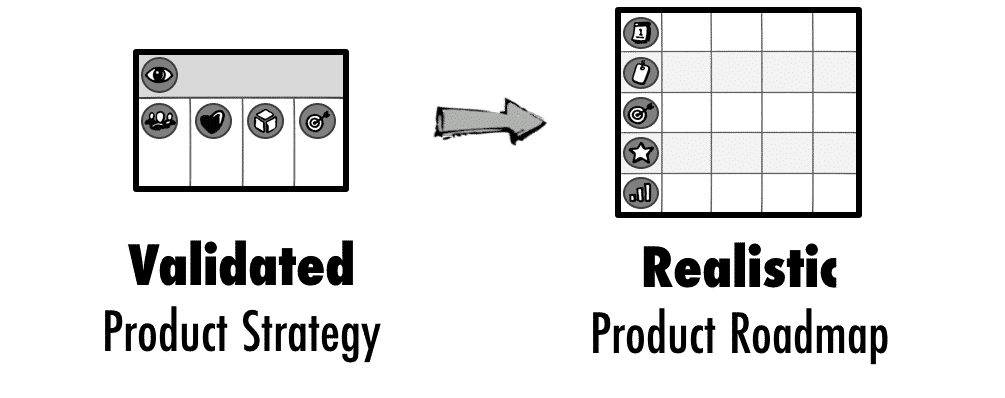
3 Tell a Coherent Story
Your product roadmap should tell a coherent story about the likely growth of your product. Each goal should build on the previous one, particularly as long as your product has not reached maturity.
To come up with the right roadmap narrative, follow these two tips: First, break the user, customer, and business goals stated in the product strategy into specific and measurable subgoals. Then order the subgoals so that they form a coherent story. If I wanted to offer a healthy eating product, for example, that helps middle-aged men reduce the risk of developing type-2 diabetes, the the goal of the first, initial release (MVP) might be to build a user community. The goal of the second release might be to increase engagement, and the goal of the third one might be to generate revenue.
Second, resist the temptation to add goals and features to the product roadmap to please powerful stakeholders or broker a deal. While I am a big fan of collaborative product roadmapping, this should not result in weak product decisions and compromises, see my tips Secure Strong Buy-in and Have the Courage to Say No below.
4 Keep it Simple
Be careful not to add too many details to your product roadmap. Keep your roadmap simple and easy to understand. Capture what really matters and leave out the rest by focusing on the goals. Keep the features on your roadmap coarse-grained and derive them from the goals. Do not show epics or user stories on your product roadmap but keep them in the product backlog. Use the product roadmap as a strategic product plan and the product backlog as a detailed one that facilitates execution, as the picture below shows.


5 Secure Strong Buy-in
The best product roadmap is worthless if the people required to develop, market, and sell the product don’t buy into it. A great way to get to agreement is to collaborate with the key stakeholders and involve them in creating and updating the product roadmap. This allows you to leverage their ideas and knowledge, it creates shared understanding, and it makes it more likely that people will support the plan.
Running a collaborative roadmapping workshop is a great way to engage everyone and create a shared product roadmap, as the following picture illustrates.

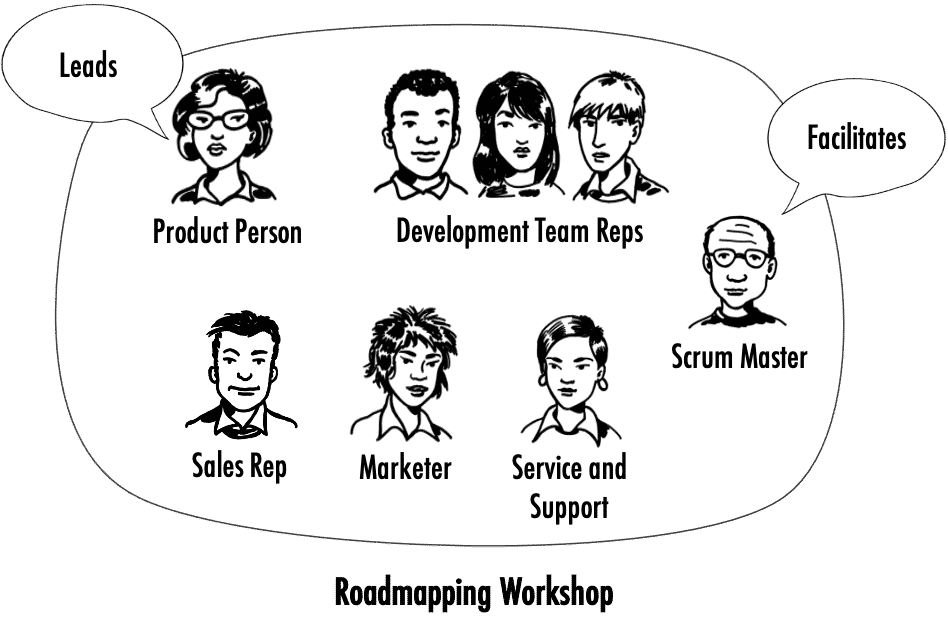
Make sure, though, that you ask a skilled facilitator, for instance, your Scrum Master, to facilitate the workshop. This includes choosing the right decision rule, for example, consent, and ensuring that everyone is heard and nobody dominates. (See my article Making Effective Product Decisions for more help on how to successfully decide with stakeholders and dev team members.)
6 Have the Courage to Say No
While you want the key stakeholders to support the product roadmap, you should not make the mistake to say yes to every idea and request. This would turn your product into a feature soup, a random collection of features. “Innovation is not about saying yes to everything. It’s about saying no to all but the most crucial features,” said Steve Jobs. Use your vision and product strategy to make the right decisions.
But before you explain why an idea or request cannot be added to the product roadmap, carefully listen to the stakeholder’s idea. Take a genuine interest in what the individual has to say and seek to understand her or his underlying need or motivation. This makes the person feel valued and understood, which will make it more likely that the individual is able to hear a negative answer and is still willing to support the roadmap. (See also my article 5 Tips Saying No Stakeholders.)
7 Know When to Show Dates
Dates on product roadmaps has been a hotly debated topic amongst some product people for a while. I recommend using dates or time frames on an internal roadmap that coordinates the work carried out by the internal stakeholders, such as, marketing, sales, and support, and the development team. This helps you make important trade-off decisions between shipping on time and fully meeting a goal. What’s more, it provides clarity for the stakeholders and development teams helping them do their work.
But when you use an external roadmap that is shown to customers and users and often used as a sales tool, then I suggest not showing any dates or time frames but sequencing your releases and possible employing a now-next-later grid to order them. Please see my article “Should Product Roadmaps Have Dates?” for more information.
8 Make your Roadmap Measurable
When using a goal-oriented roadmap, ensure that every goal is specific and measurable so you can tell if you have met the goal or not. If your goal is to acquire customers, for example, then ask yourself how many new customers should be acquired; and if your goal is to reduce technical debt, determine how much of the bad code should be removed or rewritten.
If you don’t state a target, it will be hard to tell if you have met the goal or not. Make sure, though, that you state a realistic target, and that the goals on your roadmap are feasible. Then select the metrics that will help you determine if a goal has been met and if a goal has been met and the desired benefit has materialised.
9 Determine Cost Top-Down
Whenever your product experiences a significant amount of change and innovation, I recommend that you do not attempt to determine the development cost bottom-up but rather top-down. It’s virtually impossible to derive the right epics and user stories from the roadmap features, get correct estimates from your team, and accurately anticipate the velocity and the rate of change in the product backlog. Even if you manage to make it work, you will end up with an overly long and complex product backlog that is difficult to adjust and maintain. What’s more, it can take days—and in some cases weeks—to turn the features into well-defined requirements and to come up with detailed estimates.
Instead, determine how many people with which skills are likely to be required to create the desired releases on the roadmap. Draw on your experience of developing similar products or previous versions of the same product; consider whether enough people with the right expertise are available in your company, or if you will have to hire or contract people. This should give you an indication of the likely labor cost required. Then add the cost for facilities, infrastructure, materials, licenses, and other relevant items. Carry out this exercise together with the development team.
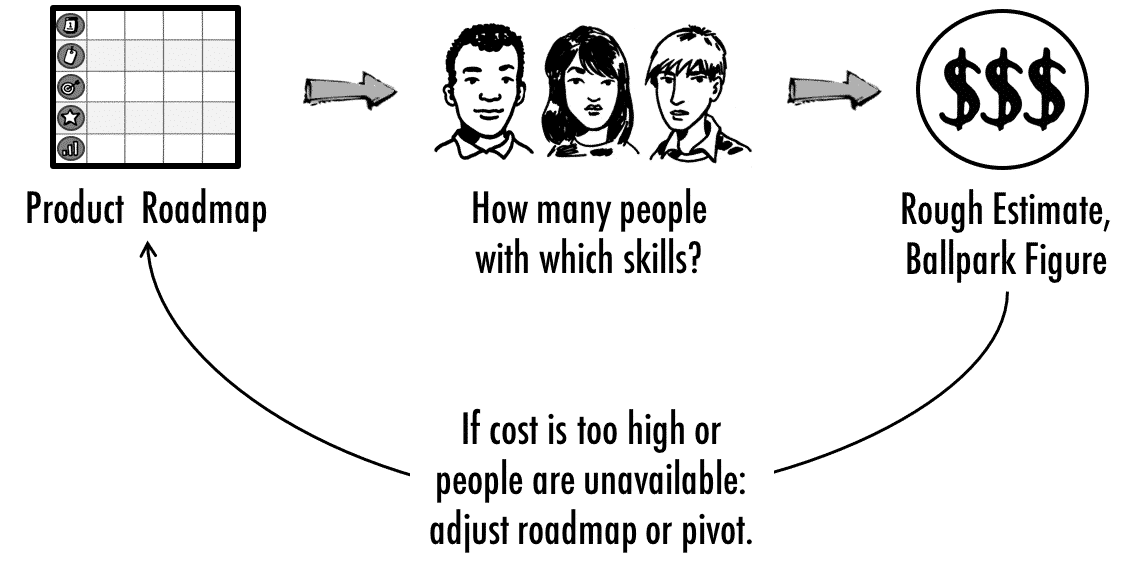
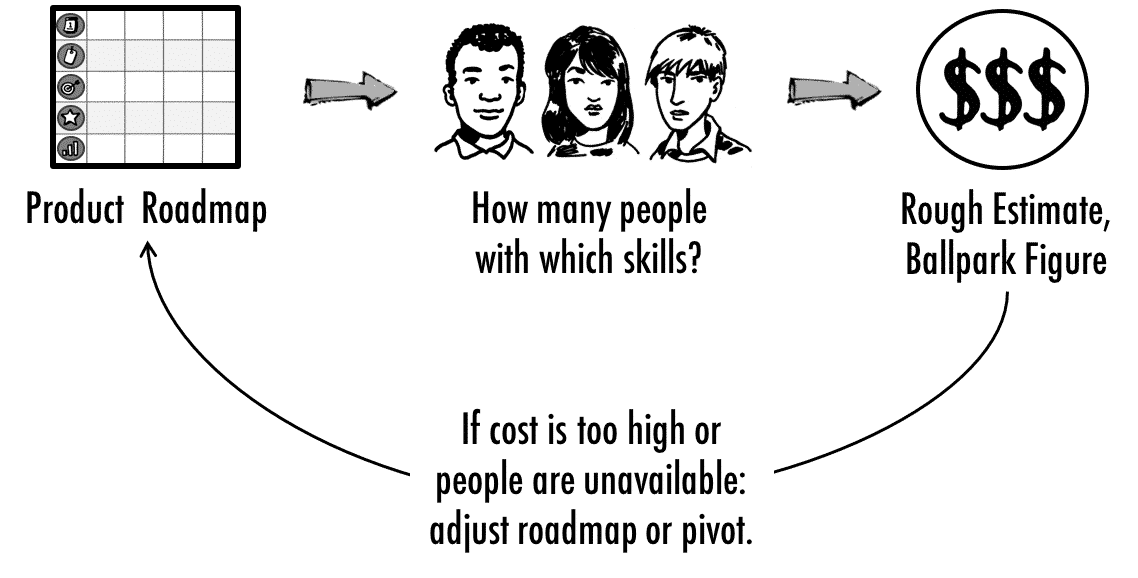
10 Regularly Review and Adjust the Roadmap
Last but not least: If the environment you’re in is agile, then change is likely to occur. You should therefore regularly review and update your product roadmap—between every four weeks to every three months depending on how young your product and how dynamic the market is.

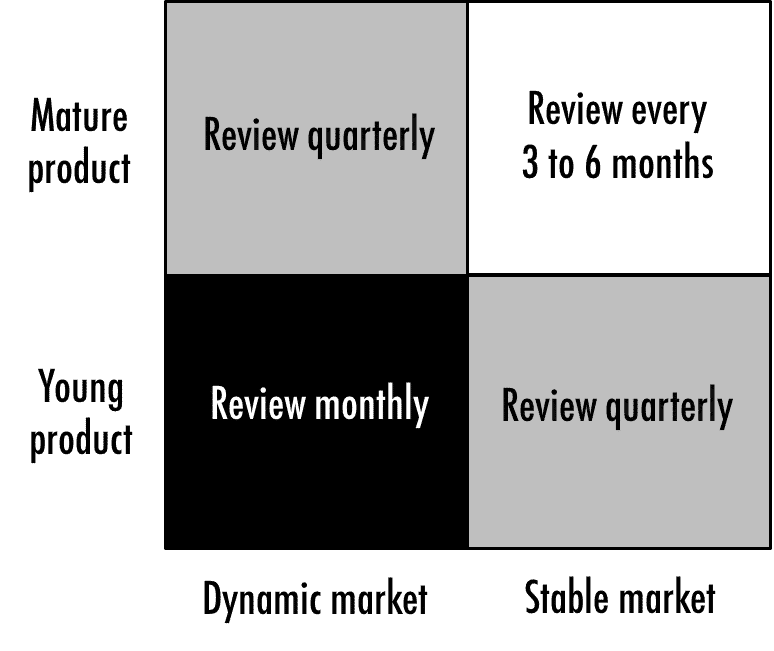
Combine your product roadmap and product strategy reviews. This ensures that the two plans are kept in synch, that bigger roadmap changes are reflected in the strategy and vice versa.


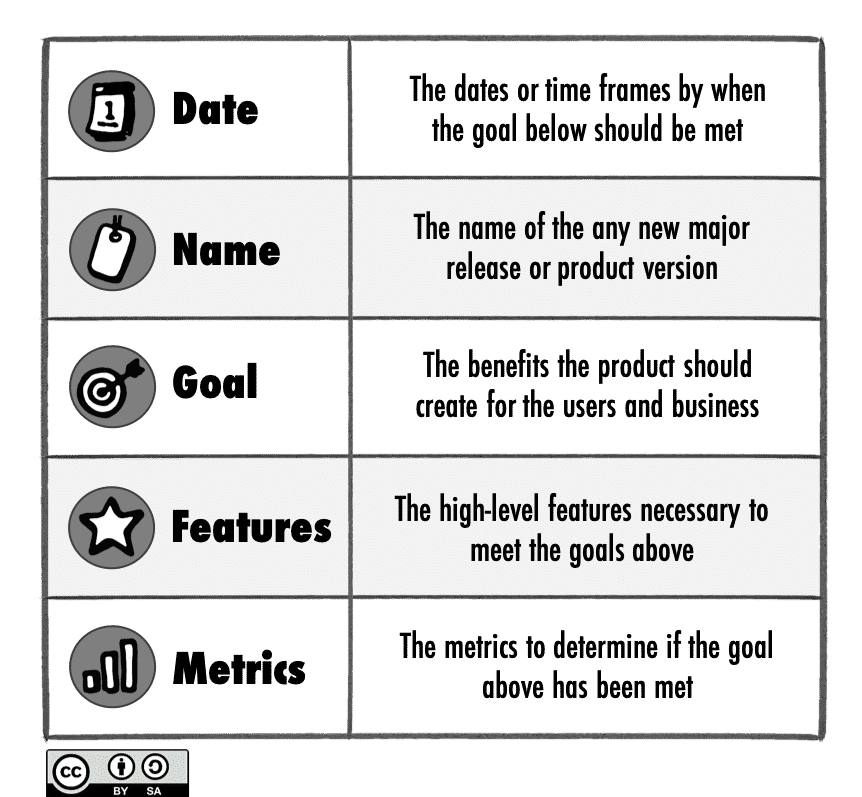
Post a Comment or Ask a Question
24 Comments
What a great article!
Thank you Yazan! I’m glad that you like it.
I work for a state agency. We have been using agile approach to our system enhancements or fixes. I just read this article to learn what a product roadmap is. I am the product owner for one of our key mission critical systems. It is difficult for me to consider some of the elements of this roadmap as we have constraints to our system that a private business wouldn’t have. As you can imagine it is top down driven, support staffing and budget limited and the customers we support are most often internal. How could we write a product roadmap with these constraints, any ideas would be helpful. Thanks.
Hi Sara,
Thank you for sharing your question. There are two things I would suggest: First, try to agree on outcome-based goals with your stakeholders and development teams rather than focussing on features and pieces of functionality. When someone comes to you with a feature request explore its benefits after having attentively listened to the individual. Would it, for example, reduce cost or increase productivity? Secondly, try to bring the key stakeholders and dev team representative together, be it in an online or onsite meeting. Jointly discuss the roadmap to leverage people’s expertise, ensure that there is a shared understanding, and maximise the chances that people support the product roadmap. Hope this helps!
Your article has given me lots of ideas. Such great information shared through this article. Its really helpful for me. Thanks for sharing keep up the good work.
Thank you for your kind feedback Logan. I am glad that you found the article helpful.
Your blogs are always helpful and who are managing the agile projects, they can get useful tips after reading this article. Thanks for sharing this useful info.
Hi Roman,
Thank you for sharing your knowledge of Agile product management! I learned a lot from your books (Strategize) and your blogs.
Regarding setting the release goals on product roadmap, I have one question:
Should we set goal from perspectives of company’s benefits (business goals) or from user’s perspectives? Example of company business perspective goal might be “increase retention rate by 2%”. Example of user perspective goal might be “Optimize the user experiences” .
Thanks,
Wei
Hi Wei,
Thank you for your feedback and question. If your product’s business goals are tied to the user needs/goals, which I would recommend, then you can choose either option. I’ve used business goals in past and expressed the user benefit indirectly by deriving the appropriate features. But you may want to try working with dual goals, for example, “Make it easier for users to do and increase retention by“, in order to clearly express the benefits for the users and business. I’ve written more about the relationship of product strategy and roadmap goals in my article “Leading through Shared Goals“.
Hope this helps!
I just stumbled upon this article – still relevant in 2019!
I think the hardest part of product management is getting buy-in, and creating alignment to go from vision to execution via the feature roadmap.
I have been running a bunch of workshops using a tool similar to your Product canvas, and simply getting people to focus on our goals up front has been great at killing off any discussion about features that aren’t contributing to our strategic objectives.
Thank you for your feedback Steve. Great to hear that you find it helpful to align people through shared goals.
Number 8 is so important — thanks for mentioning that! I think it’s really easy to launch something and forget to look back and report on the success of it after the fact, but by writing in metrics to measure it by during the planning process, you’re in a sense holding yourself accountable to measure by those metrics later on.
Great article – I just finished reading Strategize and this is a good breakdown of the key points I used to get buy in from/feedback from the team/senior management .
One question if I may. Our current roadmap also has the development time blocked out to show when the team is working on a feature – does this need to be included or should the roadmap just show targeted release?
Many Thanks
Simon
Thanks for your feedback and question Simon. I would be hesitant to show when a feature will be developed on a product roadmap. A release plan is better suited to do this if required. Please take a look at my post The Product Roadmap and the Release Plan. Hope this helps!
Very good post. User feedback and surveying is another important part that I think all product managers should do as well 🙂
Very insightful! Thank you for this article. I especially like the part about creating a story about the product. I’m now thinking of launching a new product on the market and this article helped me a lot.
Fab article. So clear and straightforward. Thanks for sharing.
Great article. Very helpful and simplistic way to break down some of the challenging pieces of managing products in an Agile environment.
Thanks for your feedback Josh! Glad to hear that you have found my post helpful.
I am trying to find ways to start a new product. I am reading your posts and video for the last 2 hours, and convinced to use these steps you wrote above 🙂
I am curious about “5 Get Buy-in” step in details. Another post just for this step would be great. Just a little feedback.
Thank you.
Answered a lot of questions that I had from watching the video; many thanks. Looking forward to using the GO roadmap for new proects going forward.
Thanks for your feedback and good luck with applying the GO roadmap!
Like so many brilliant ideas, the greatness lies in it’s simplicity.
I’ve spent weeks trying to explain a new product concept to senior management without success.
Then I took a couple of hours to put together a Vision Board and Go Roadmap with my team. The bosses finally get it and the development team has a well defined sense of direction.
Thanks for your kind feedback, Hodmi. I am glad that the Vision Board and the GO Roadmap have been helpful for you.